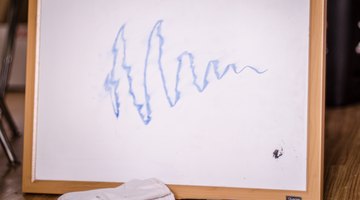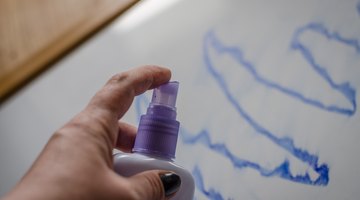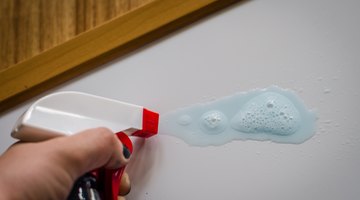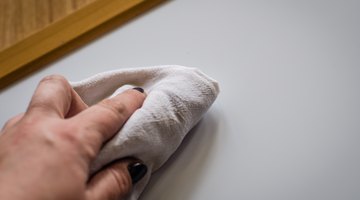How to Restore a Dry-Erase Board
If you use the dry-erase board frequently or sometimes leave ink on it for days or weeks on end, it may show signs of use and abuse: ink that doesn't wipe off easily, smeared color left behind from markers, or a writing surface that simply doesn't look clean, no matter how many times you clean it.

Restore the board with rubbing alcohol and simple stain-removing solutions to return the board to a clean condition.
Restoring the Board

Before restoring the board, erase as many marks as possible; then wipe it down with a dedicated dry-erase board cleaner designed for your brand or type of board. Boards vary greatly in the materials they're made from; some manufacturers recommend the same type of board cleaner for all of their dry-erase boards, while others offer various options. After cleaning the board, wipe it down with a soft cloth dipped in equal parts water and rubbing alcohol. Alcohol removes many types of ink-based residue. Wipe the board down again with clear water using a non-abrasive cloth; then dry it with a fresh non-abrasive cloth. For best results, use only white cloths to prevent dye from getting on the board.
Removing Marker Stains

Mistakes happen -- if both permanent and dry-erase markers are kept in the same general area, you may wind up with permanent ink on the dry-erase board. The eraser designed for the board isn't designed to erase permanent ink. Instead of scrubbing the board with abrasive cleaners -- which should never be done -- draw over the permanent ink with a black dry-erase marker. Scribble over the old marks enough to cover them completely, then, once the dry-erase ink dries, wipe both inks away with the eraser you use on the board.
Stubborn-Stain Removal

If some of the stains don't come off with standard dry-erase board cleaners, apply a citrus-based stain solution such as a sticker and adhesive remover directly over the affected areas using a soft cloth. Afterwards, wipe the area clean with a damp cloth; then dry it with another soft cloth.
Preventive Maintenance

Sometimes, the manner in which the board is used or cleaned may cause erasability issues. Always allow the marker ink to dry for at least 10 seconds before erasing it; otherwise, wet ink may smear or "ghost" over the board when you use the eraser. Clean the board with a dedicated board cleaner at the end of each day of use, or several times per week; the longer ink is left on the board, the more difficult it is to remove. A glass cleaner may be used on some brands of boards; consult the manufacturer's website for instructions specific to your dry-erase board model, as some specifically state not to use glass cleaners. When erasers appear dirty, replace them with clean ones.
The Drip Cap
- If you use the dry-erase board frequently or sometimes leave ink on it for days or weeks on end, it may show signs of use and abuse: ink that doesn't wipe off easily, smeared color left behind from markers, or a writing surface that simply doesn't look clean, no matter how many times you clean it.
- After cleaning the board, wipe it down with a soft cloth dipped in equal parts water and rubbing alcohol.
- Alcohol removes many types of ink-based residue.
References
Writer Bio
Kathy Adams is an award-winning writer. She is an avid DIYer that is equally at home repurposing random objects into new, useful creations as she is at supporting community gardening efforts and writing about healthy alternatives to household chemicals. She's written numerous DIY articles for paint and decor companies, as well as for Black + Decker, Hunker, Landlordology, SFGate and others.
Photo Credits
- Sasha Shafto/Demand Media
- Sasha Shafto/Demand Media
- Sasha Shafto/Demand Media
- Sasha Shafto/Demand Media
- Sasha Shafto/Demand Media
- Sasha Shafto/Demand Media
More Articles



